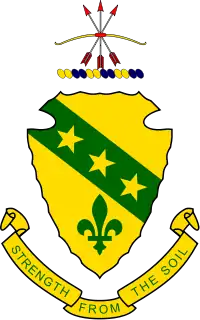John Burke (politician)
John Burke (February 25, 1859 – May 14, 1937) was an American lawyer, jurist, and political leader from North Dakota. He was the tenth Governor of North Dakota.[1]
John Burke | |
|---|---|
_(cropped).jpg.webp) Governor Burke, 1908 | |
| 24th Treasurer of the United States | |
| In office April 1, 1913 – January 5, 1921 | |
| Appointed by | Woodrow Wilson |
| Preceded by | Carmi A. Thompson |
| Succeeded by | Frank White |
| 10th Governor of North Dakota | |
| In office January 9, 1907 – January 8, 1913 | |
| Lieutenant | Robert S. Lewis Usher L. Burdick |
| Preceded by | Elmore Y. Sarles |
| Succeeded by | L. B. Hanna |
| Member of the North Dakota Senate | |
| In office 1893–1896 | |
| Member of the North Dakota House of Representatives | |
| In office 1891 | |
| Personal details | |
| Born | February 25, 1859 Keokuk County, Iowa, U.S. |
| Died | May 14, 1937 (aged 78) Rochester, Minnesota, U.S. |
| Political party | Democratic |
| Spouse(s) | Mary Kane |
| Profession | Lawyer |
| Signature | |
Biography
Burke was born in Keokuk County, Iowa of Irish ancestry to John and Mary (née Ryan) Burke. He graduated from the University of Iowa with a law degree in 1886. He married Mary E. Kane, a teacher, on August 22, 1891, and they had a son, Thomas, and two daughters, Elizabeth and Marian.[2]
Career
Burke's legal career was established in Iowa and Minnesota before he moved to the Dakota Territory. After North Dakota was admitted to the union, he served in the state's House of Representatives in 1891 and in its Senate from 1893 to 1896. He served three terms (1907–1913) as the tenth Governor of North Dakota.
At the 1912 Democratic National Convention in Baltimore, Burke enthusiastically supported the candidacy of Woodrow Wilson. Burke swung all of North Dakota's votes to Wilson on the first ballot. William Jennings Bryan, himself a supporter of Wilson and also a good friend of Burke's, wanted Burke to run for Vice-President. Burke demurred, however, due to a promise he had given Indiana delegates for their votes. As a result, Thomas R. Marshall of Indiana was chosen for Vice-President. Burke was named United States Treasurer following Wilson’s election victory in November 1912. From 1913 to 1921 Burke was Treasurer of the United States, under President Woodrow Wilson. Burke ran unsuccessfully for the United States Senate in 1916.
Death and legacy
He later served as a justice of the North Dakota Supreme Court from 1924 until his death on May 14, 1937. Burke County, North Dakota is named in his honor. His remains are interred in Saint Mary's Cemetery, Bismarck, North Dakota. The State of North Dakota donated a statue of Burke to the United States Capitol's National Statuary Hall Collection in 1963. There is also a statue of Burke at the State Capitol grounds in Bismarck, ND.

See also
- List of Liberty ships
- Liberty Ship SS John Burke
References
- "John Burke". National Governors Association. Retrieved 5 September 2012.
- "John Burke". Soylent Communications. Retrieved September 5, 2012.
External links
| Wikimedia Commons has media related to John Burke (politician). |
- John Burke Papers at The University of North Dakota
- National Statuary Hall Collection includes biography and photo of statue.
- John Burke at Find a Grave
- National Governors Association
| Party political offices | ||
|---|---|---|
| Preceded by Marthinus F. Hegge |
Democratic nominee for Governor of North Dakota 1906, 1908, 1910 |
Succeeded by Frank O. Hellstrom |
| First | Democratic nominee for U.S. Senator from North Dakota (Class 1) 1916 |
Succeeded by James Francis Thaddeus O'Connor |
| Political offices | ||
| Preceded by Carmi A. Thompson |
Treasurer of the United States April 1, 1913–January 5, 1921 |
Succeeded by Frank White |
| Preceded by Elmore Y. Sarles |
Governor of North Dakota 1907–1913 |
Succeeded by L. B. Hanna |
| Legal offices | ||
| Preceded by William Nuessle |
Chief Justice of North Dakota 1929–1931 |
Succeeded by Adolph M. Christianson |
| Preceded by Alexander Burr |
Chief Justice of North Dakota 1935–1937 |
Succeeded by Adolph M. Christianson |

